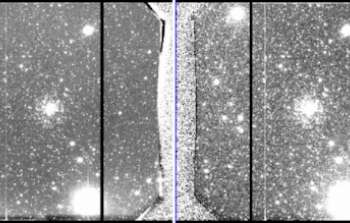sci18102 — Announcement
GMOS-S Bubbles No More - The Proof
September 25, 2018
In the previous e-Newscast we reported on the completion of the remedial work to resolve the issue of air bubbles that over time had developed on some of the oil interfaces between optical lenses of the Gemini Multi-Object Spectrograph at Gemini South (GMOS-S). This work required disassembly of the instrument which a somewhat risky intervention. Now, the instrument is back on sky and we have verified that all is well as the images shown here prove.
The first set (top) of daytime images, making use of the “pinhole camera” configuration using the dome lights as the illumination source, bring to sharp focus the bubbles in the optical system of the instrument. The image on the left was taken before and the one on the right after the intervention. Disregard the overall stripe pattern which is due to the primary mirror cover, but look at the effects of the bubbles at the bottom of the field of view on the left image that are completely gone in the image on the right.
The second snapshot shows a g' band image on sky, on the left reduced with a twilight flat field taken before the intervention, and on the right with a twilight flat field taken after the intervention. As you can see the intensity gradients at the bottom are gone now, and the flat fielding is substantially improved, putting an end to a long-standing difficulty with imaging data reduction.
About the Announcement
| Id: |
ID
sci18102
|

